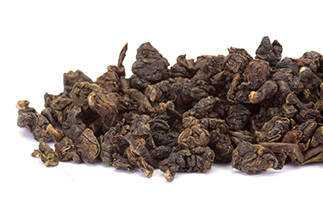Origin: Riyuetan (Sun Moon Lake, 日月潭, rìyuètán), Nantou County (南投縣, nántóu xiàn), Taiwan.
This mountain lake is surrounded by mountain ranges on all sides, has a stable average annual temperature and high humidity. Together, these factors create ideal conditions for growing tea. Riyuetan is one of Taiwan's thirteen national scenic areas (國家級風景特定區).
There are two points to note in the history of this variety. In the 1920s, Assam bushes were introduced in the city district of Yuchi (魚池鄉, yúchí xiāng), and their active selection began as a further basis for red tea. Later, in the 1980s, gaba tea technology was developed in Japan. Nowadays, Taiwanese specialists combine approaches to obtain a product with new properties - red gaba tea.
Appearance, aroma and taste
The tea leaves are twisted longitudinally and resemble brown nubuck in color and texture. The infusion is fiery orange. The flavor is floral and fruity with predominant notes of wild strawberry and acacia honey. The sip ends with a persistent spicy aftertaste.
In addition to red Gaba, we recommend trying Gaba based on Taiwanese oolongs.
Copyright © Chaline.Ru
The aroma of dry tea is bright, spicy-floral, voluminous. The notes of dried cloves, wild rose petals, and fruits predominate. The washed tea leaves reveal aromas of a blooming garden, shades of oriental spices, and tropical fruits warmed in the sun.
The taste of Zhiyuetan GABA is soft and gentle. The taste has spicy-floral notes, wild rose and rosehip petals, flower honey. On the 3rd steeping, the tea becomes lighter and airier. A bright floral-fruity trail appears in the taste.
This tea can be brewed 5 times. To prepare the infusion, take 5-7 grams of dry tea leaves per gaiwan or teapot with a capacity of 150 ml. The color of the resulting infusion is dark amber, deep and juicy.
During tea drinking, the tea leaves a light, delicate aftertaste in the mouth, with floral notes and a hint of tropical fruits.
Red GABA tea "Zhiyuetan" has a unique effect. It lifts the mood very well and helps to overcome depression, relaxes the body, immerses a person "into himself" and gives a meditative state.
GABA increases the body's ability to resist stress and nervous tension. Tea activates brain activity, improves its performance.
This tea will appeal to all lovers of red tea, shu puer, and any other highly fermented tea.
|
Name in Chinese
|
日月潭 |
|
Pinyin
|
rìyuètán |
|
English name
|
Gaba |
|
Translation
|
Zhiyuetan |
|
Tea variety
|
Sun Moon Lake |
|
Country
|
Taiwan |
|
District
|
Nantou (南投縣) |
|
Provinces
|
Liaoning (辽宁) |
|
Region
|
Nantou (南投) |
|
Habitat
|
Жиюэтань, уезд Наньтоу |
|
Tea tree (bush) variety
|
Qing Xin |
|
Type of tea
|
Gaba Tea |
- Комментарии
- Вконтакте
Свое название ГАБА-чай получил из-за высокого содержания в своем составе гамма-аминомасляной кислоты (по-английски — Gamma-aminobutyric acid, GABA). Гамма-аминомасляная кислота, в сочетании с другими компонентами чая, оказывает на организм человека совершенно удивительное и комплексное воздействие. Она понижает артериальное давление, помогает при атеросклерозе, головных болях и головокружениях, при морской болезни, стимулирует мозговую деятельность в частности и динамику нервных процессов вообще, улучшает мышление и память, снимает похмельный синдром, обладает высоким антиоксидантным действием — а это значит, что может иметь профилактическое антираковое действие. Гамма-аминомасляная кислота по своему действию аналогична транквилизаторам (диазепам, феназепам), но при этом не вызывает привыкания.





















































































